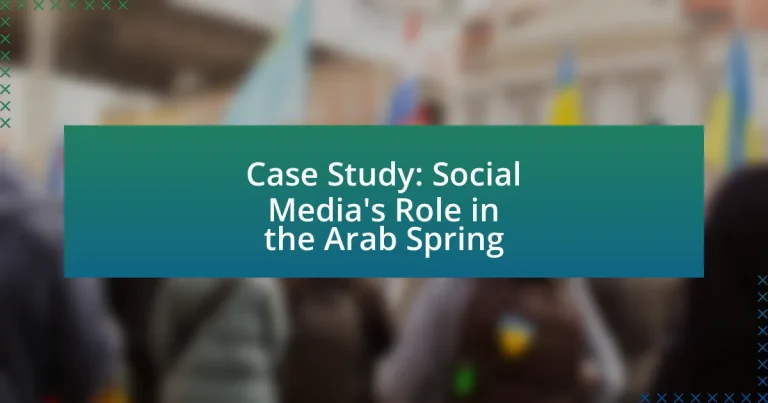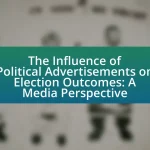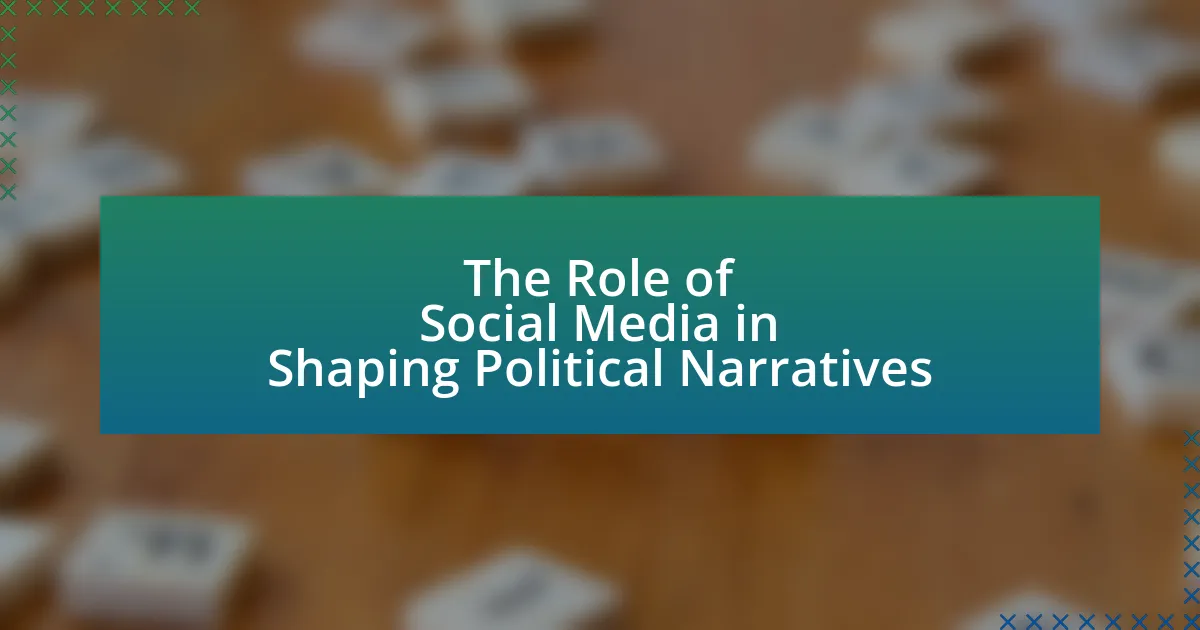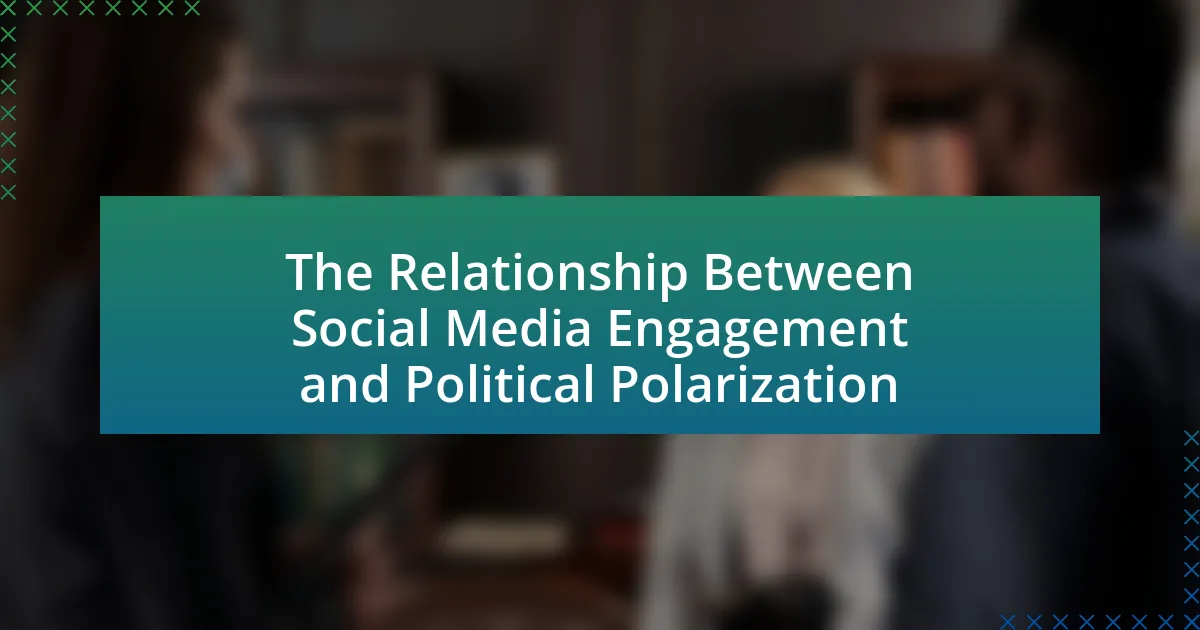The article examines the pivotal role of social media during the Arab Spring, highlighting how platforms such as Facebook, Twitter, and YouTube facilitated communication, mobilization, and information dissemination among protesters. It details specific instances, such as the protests in Tunisia and Egypt, where social media bypassed state-controlled media, enabling grassroots organizing and shaping public narratives. The article also discusses the long-term impacts of social media on political landscapes in the region, the responses of governments to online activism, and the lessons learned for future movements regarding effective social media use and strategies to counteract potential government crackdowns.
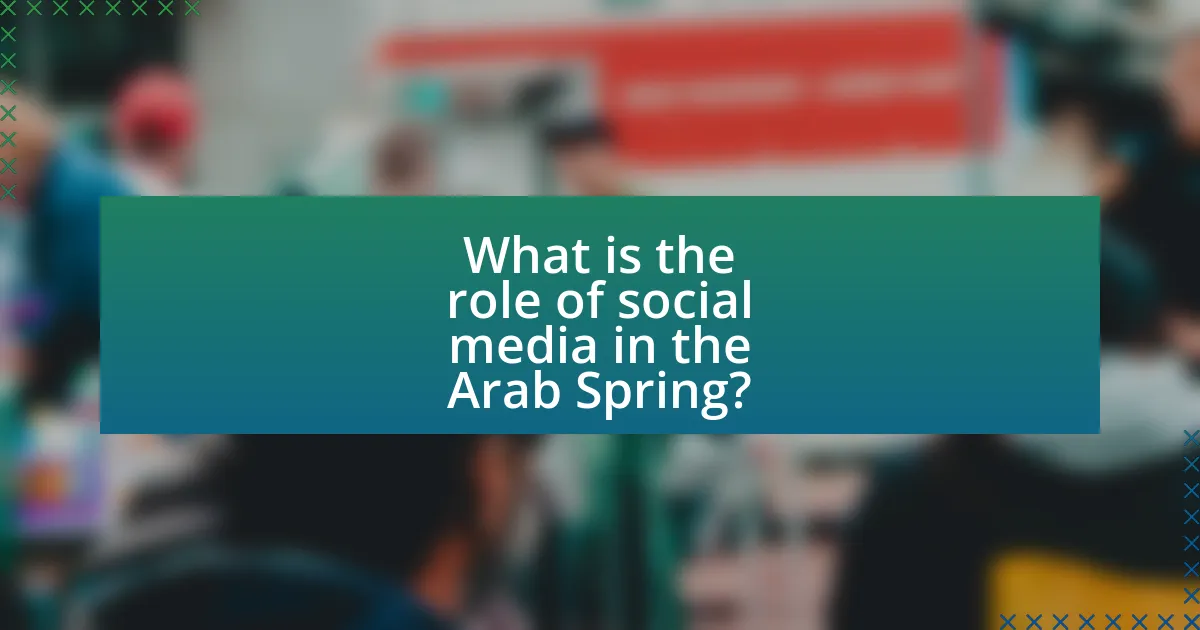
What is the role of social media in the Arab Spring?
Social media played a crucial role in the Arab Spring by facilitating communication, mobilization, and the dissemination of information among protesters. Platforms like Facebook and Twitter enabled activists to organize demonstrations, share real-time updates, and spread awareness about government oppression. For instance, in Tunisia, social media was instrumental in coordinating protests that led to the ousting of President Zine El Abidine Ben Ali in January 2011. The rapid sharing of videos and images of protests galvanized support and inspired similar movements across the region, including in Egypt, where social media helped organize the massive protests in Tahrir Square that resulted in the resignation of President Hosni Mubarak. The ability of social media to bypass state-controlled media and connect individuals across geographical boundaries significantly amplified the voices of dissent and contributed to the overall momentum of the Arab Spring.
How did social media platforms facilitate communication during the Arab Spring?
Social media platforms facilitated communication during the Arab Spring by enabling rapid information sharing and mobilization among protesters. Platforms like Facebook and Twitter allowed individuals to organize demonstrations, share real-time updates, and disseminate news that traditional media often overlooked or censored. For instance, in Tunisia, the use of Facebook was pivotal in coordinating protests that led to the ousting of President Zine El Abidine Ben Ali in January 2011, with reports indicating that over 1.5 million Tunisians were active on the platform at that time. Additionally, social media served as a tool for international awareness, as images and videos of protests spread globally, garnering support and solidarity from outside the region.
What specific platforms were most influential in the Arab Spring?
The specific platforms most influential in the Arab Spring were Facebook, Twitter, and YouTube. Facebook served as a primary tool for organizing protests and sharing information, with over 1 million users in Egypt by 2011, facilitating rapid mobilization. Twitter played a crucial role in real-time updates and spreading news, with hashtags like #Jan25 becoming symbols of the movement. YouTube was instrumental in broadcasting events and documenting human rights abuses, allowing global audiences to witness the uprisings firsthand. These platforms collectively enabled activists to communicate, organize, and raise awareness, significantly impacting the course of the Arab Spring.
How did social media enable grassroots organizing and mobilization?
Social media enabled grassroots organizing and mobilization by providing a platform for rapid communication and coordination among activists. During the Arab Spring, platforms like Facebook and Twitter facilitated the sharing of information, allowing individuals to organize protests and disseminate messages quickly. For instance, the use of Facebook events helped mobilize thousands of people in Tunisia and Egypt within a short time frame, demonstrating the effectiveness of social media in rallying support and fostering collective action. Additionally, social media bypassed traditional media censorship, enabling activists to share real-time updates and garner international attention, which further amplified their efforts.
Why was social media considered a revolutionary tool during the Arab Spring?
Social media was considered a revolutionary tool during the Arab Spring because it facilitated rapid communication and organization among protesters. Platforms like Facebook and Twitter enabled individuals to share information, mobilize support, and coordinate protests in real-time, bypassing state-controlled media. For instance, the use of social media in Tunisia helped spark the initial protests that led to the ousting of President Zine El Abidine Ben Ali in January 2011, demonstrating its power to influence political change. Additionally, studies, such as those by the Pew Research Center, indicate that social media played a crucial role in raising awareness and fostering solidarity among diverse groups, ultimately contributing to the widespread uprisings across the region.
What unique features of social media contributed to its effectiveness?
Social media’s effectiveness during the Arab Spring was significantly enhanced by its unique features, including real-time communication, widespread accessibility, and user-generated content. Real-time communication allowed activists to share information instantly, facilitating rapid mobilization and coordination of protests. Widespread accessibility ensured that a large segment of the population could participate in discussions and disseminate information, as platforms like Facebook and Twitter were available on various devices and in multiple languages. User-generated content empowered individuals to share their experiences and perspectives, creating a diverse narrative that resonated with both local and global audiences. These features collectively enabled social media to serve as a powerful tool for organizing and amplifying voices during the Arab Spring, as evidenced by the significant role these platforms played in events such as the protests in Tunisia and Egypt.
How did social media challenge traditional media narratives?
Social media challenged traditional media narratives by providing a platform for real-time reporting and grassroots storytelling during the Arab Spring. Unlike traditional media, which often relied on government sources and editorial gatekeeping, social media allowed individuals to share their experiences and perspectives directly, bypassing conventional filters. For instance, during the protests in Egypt, platforms like Twitter and Facebook enabled activists to disseminate information rapidly, mobilize support, and document events as they unfolded, often contradicting state-controlled narratives. This shift in information dissemination empowered citizens and altered the dynamics of news coverage, as seen in the widespread sharing of videos and images that highlighted the realities of the protests, which traditional media outlets were slow to cover or misrepresented.
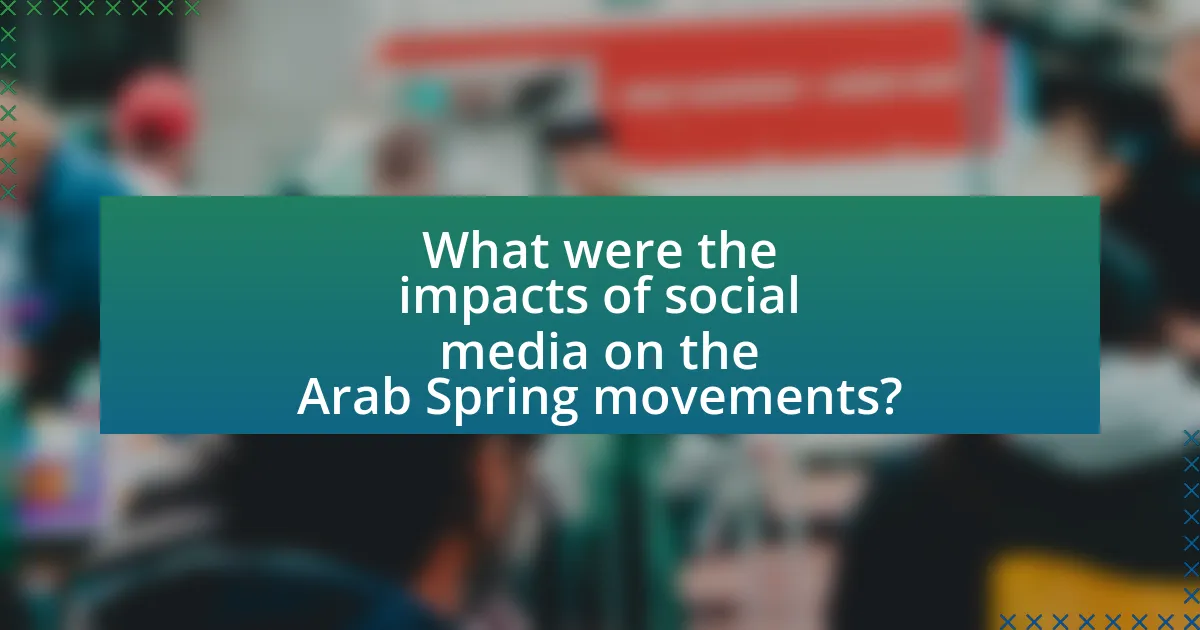
What were the impacts of social media on the Arab Spring movements?
Social media significantly impacted the Arab Spring movements by facilitating communication, mobilization, and the dissemination of information. Platforms like Facebook and Twitter enabled activists to organize protests, share real-time updates, and bypass state-controlled media. For instance, in Tunisia, social media played a crucial role in the coordination of protests that led to the ousting of President Zine El Abidine Ben Ali in January 2011. Additionally, studies indicate that social media helped raise global awareness and support for the movements, as images and videos of protests spread rapidly online, influencing public opinion and international responses.
How did social media influence public perception and awareness?
Social media significantly influenced public perception and awareness during the Arab Spring by facilitating real-time communication and information sharing among activists and the general populace. Platforms like Facebook and Twitter enabled individuals to disseminate news, mobilize protests, and share personal experiences, which helped to shape public opinion and raise awareness about political injustices. For instance, the use of hashtags such as #Jan25 during the Egyptian revolution galvanized support and drew international attention, illustrating how social media served as a catalyst for collective action and a tool for amplifying voices that were previously marginalized. This rapid spread of information contributed to a heightened sense of urgency and solidarity among citizens, ultimately impacting the political landscape in several countries involved in the uprisings.
What role did social media play in shaping the narrative of protests?
Social media played a crucial role in shaping the narrative of protests during the Arab Spring by facilitating rapid information dissemination and mobilization of supporters. Platforms like Facebook and Twitter enabled activists to share real-time updates, organize events, and amplify their messages, which significantly influenced public perception and international attention. For instance, the use of hashtags such as #Jan25 during the Egyptian revolution helped unify diverse groups and attract global media coverage, thereby framing the protests as a widespread demand for democracy and human rights. This digital engagement not only empowered local voices but also challenged state-controlled narratives, illustrating the transformative impact of social media on political movements.
How did social media affect international attention and support for the movements?
Social media significantly increased international attention and support for the movements during the Arab Spring by facilitating real-time communication and information sharing. Platforms like Twitter and Facebook allowed activists to broadcast their messages globally, garnering sympathy and solidarity from international audiences. For instance, the hashtag #Jan25 became a rallying point for the Egyptian revolution, drawing global media coverage and prompting international organizations to express support for the protesters. Additionally, social media enabled the rapid dissemination of images and videos depicting government crackdowns, which mobilized global outrage and led to calls for intervention from foreign governments and NGOs. This interconnectedness amplified the movements’ visibility and helped sustain momentum by attracting international allies and resources.
What were the consequences of social media use during the Arab Spring?
The consequences of social media use during the Arab Spring included the facilitation of mass mobilization, the spread of information, and the shaping of public discourse. Social media platforms like Facebook and Twitter enabled activists to organize protests, as seen in Egypt where the January 25 Revolution was largely coordinated through these channels. Additionally, social media served as a tool for real-time information dissemination, allowing citizens to share news and updates that traditional media often censored. This led to increased awareness and engagement among the populace, contributing to the rapid spread of protests across multiple countries in the region. The impact of social media was significant in altering the political landscape, as it empowered ordinary citizens to challenge authoritarian regimes and demand democratic reforms.
How did governments respond to the use of social media by protesters?
Governments responded to the use of social media by protesters during the Arab Spring with a combination of censorship, surveillance, and repression. For instance, regimes in countries like Egypt and Tunisia temporarily shut down internet access and blocked social media platforms to disrupt communication among protesters. Additionally, governments employed surveillance tactics to monitor online activities and identify activists, leading to arrests and crackdowns on dissent. The Egyptian government, for example, arrested numerous individuals for their online activities, demonstrating a direct response to the mobilization facilitated by social media. These actions highlight the significant threat that governments perceived from the organizing power of social media during the protests.
What long-term effects did social media have on political landscapes in the region?
Social media has significantly altered the political landscapes in the region by facilitating greater public engagement and mobilization. This transformation is evident in the increased ability of citizens to organize protests, share information, and challenge authoritarian regimes, as seen during the Arab Spring. For instance, platforms like Facebook and Twitter enabled activists to coordinate demonstrations and disseminate real-time updates, which contributed to the toppling of governments in Tunisia and Egypt. Furthermore, the long-term effects include the emergence of new political movements and the ongoing struggle for democratic reforms, as social media continues to serve as a tool for political discourse and activism.
What lessons can be learned from social media’s role in the Arab Spring?
Social media played a crucial role in the Arab Spring by facilitating communication, mobilizing protests, and spreading information rapidly. The primary lesson learned is that social media can empower grassroots movements by providing a platform for collective action and real-time updates, as evidenced by the use of Facebook and Twitter to organize protests in Tunisia and Egypt. Additionally, social media’s ability to bypass traditional media censorship allowed activists to share their narratives directly with a global audience, which was pivotal in garnering international support. The Arab Spring demonstrated that while social media can be a powerful tool for social change, it also poses risks, such as misinformation and government surveillance, highlighting the need for digital literacy and security among activists.
How can future movements leverage social media effectively?
Future movements can leverage social media effectively by utilizing it for real-time communication, mobilization, and awareness-raising. Social media platforms enable instant dissemination of information, allowing movements to organize protests and share updates rapidly, as demonstrated during the Arab Spring where platforms like Twitter and Facebook facilitated coordination among activists. Research indicates that social media can amplify voices and reach a global audience, increasing pressure on authorities and garnering international support, which was evident when hashtags related to the Arab Spring trended worldwide, drawing attention to the movements.
What strategies can activists adopt to maximize social media’s impact?
Activists can maximize social media’s impact by employing targeted messaging, leveraging visual content, and fostering community engagement. Targeted messaging ensures that the content resonates with specific audiences, increasing the likelihood of shares and interactions; for instance, during the Arab Spring, activists used localized language and cultural references to connect with their communities effectively. Leveraging visual content, such as images and videos, enhances emotional appeal and can lead to higher engagement rates; studies show that posts with visuals receive 94% more views than text-only posts. Fostering community engagement through interactive campaigns, such as polls or live discussions, encourages participation and builds a sense of solidarity among supporters, which was evident in the mobilization efforts during the Arab Spring.
What pitfalls should movements avoid when using social media?
Movements should avoid oversimplification of messages when using social media, as this can lead to misinterpretation and dilution of their core objectives. Oversimplified narratives may attract attention but often fail to convey the complexities of the issues at hand, resulting in a lack of genuine understanding among followers. For instance, during the Arab Spring, some movements faced challenges because their messages were reduced to catchy slogans that did not encapsulate the broader socio-political context, leading to fragmented support and confusion. Additionally, movements should be cautious of echo chambers, where only similar viewpoints are shared, as this can limit constructive dialogue and alienate potential allies. Engaging with diverse perspectives can enhance credibility and foster a more inclusive movement.
What best practices emerged from the Arab Spring regarding social media use?
Best practices that emerged from the Arab Spring regarding social media use include the importance of anonymity, the strategic use of hashtags, and the establishment of secure communication channels. Anonymity allowed activists to organize and share information without fear of government retaliation, as seen in countries like Egypt and Tunisia where users created pseudonymous accounts. The strategic use of hashtags, such as #Jan25 in Egypt, helped to unify messages and mobilize support, demonstrating the effectiveness of concise and memorable tags in spreading awareness. Additionally, establishing secure communication channels, such as encrypted messaging apps, became crucial for protecting sensitive information and coordinating actions among activists, as highlighted by the use of platforms like Signal and Telegram during protests. These practices collectively enhanced the ability of social movements to leverage social media for mobilization and advocacy.
How can organizations prepare for potential government crackdowns on social media?
Organizations can prepare for potential government crackdowns on social media by developing robust communication strategies and diversifying their platforms. Establishing secure channels for information dissemination, such as encrypted messaging apps, allows organizations to maintain communication even if mainstream social media is restricted. Additionally, training staff on digital security practices, including the use of VPNs and secure passwords, enhances resilience against surveillance and censorship. Historical examples, such as the Arab Spring, demonstrate that organizations that adapted quickly to changing digital landscapes were more effective in mobilizing support and sharing information despite government interventions.
What tools and resources are available for effective social media activism?
Effective social media activism utilizes various tools and resources, including platforms like Twitter, Facebook, and Instagram, which facilitate rapid information dissemination and community engagement. These platforms enable activists to share real-time updates, mobilize supporters, and create awareness around social issues. Additionally, tools such as Hootsuite and Buffer allow for scheduling posts and analyzing engagement metrics, enhancing the strategic planning of campaigns. Resources like hashtags and viral challenges can amplify messages, while online petitions and crowdfunding platforms, such as Change.org and GoFundMe, provide avenues for action and financial support. The effectiveness of these tools is evidenced by their role in the Arab Spring, where social media was pivotal in organizing protests and spreading revolutionary ideas, demonstrating their capacity to influence political change.
